How To Play Damath (With Printable Damath Board and Chips)
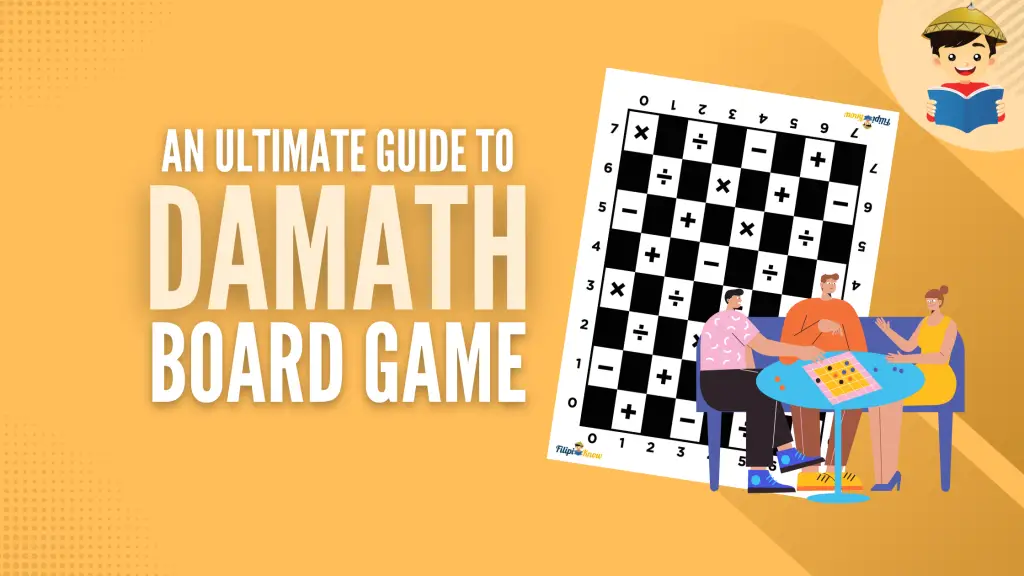
Due to boring math classes, many Filipinos have grown up believing they suck at math. But thanks to the board game Damath, studying math can become a fun and thrilling experience.
Are you thinking about learning this game? Please sit back and relax as we teach you how to play the educational board game Damath.
Table of Contents
Free Download: Printable Damath Board and Chips
Are you ready to get your feet wet with the game? You can start right now with the help of our free printable Damath board and chips.
All you have to do is click the download links below and print the downloaded files. Don’t worry because the Damath board and chips dimensions are all set. Just paste them into cardboard, cut the chips from it, and you’re ready.
1. Printable Damath Board
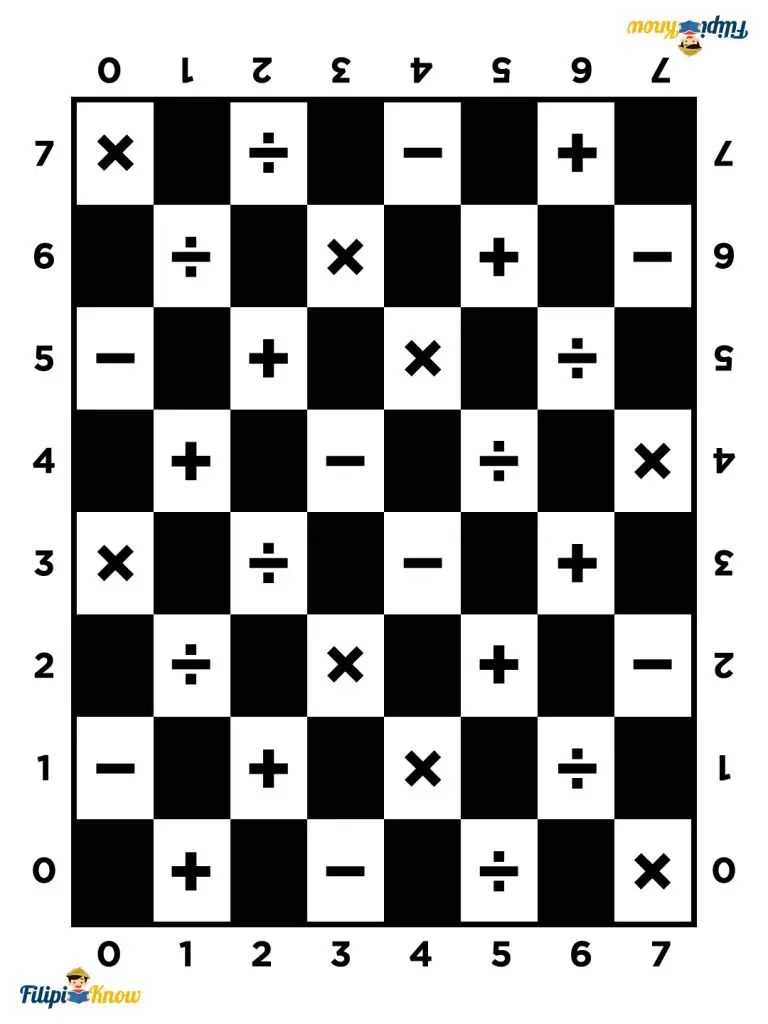
Download the Damath board in printable PDF format
2. Printable Chips
a. Counting Damath

Download the Counting Damath chips in printable PDF format
b. Whole Damath
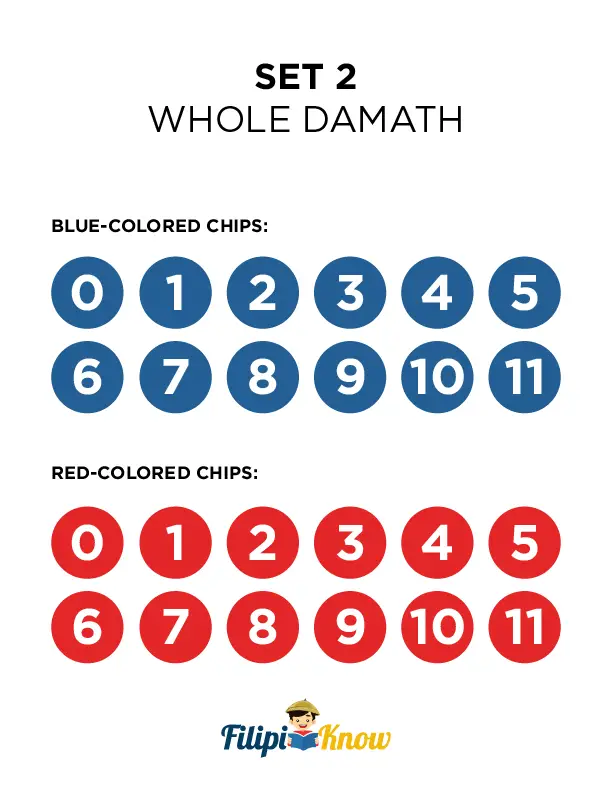
Download the Whole Damath chips in printable PDF format
c. Fraction Damath

Download the Fraction Damath chips in printable PDF format
d. Integer Damath
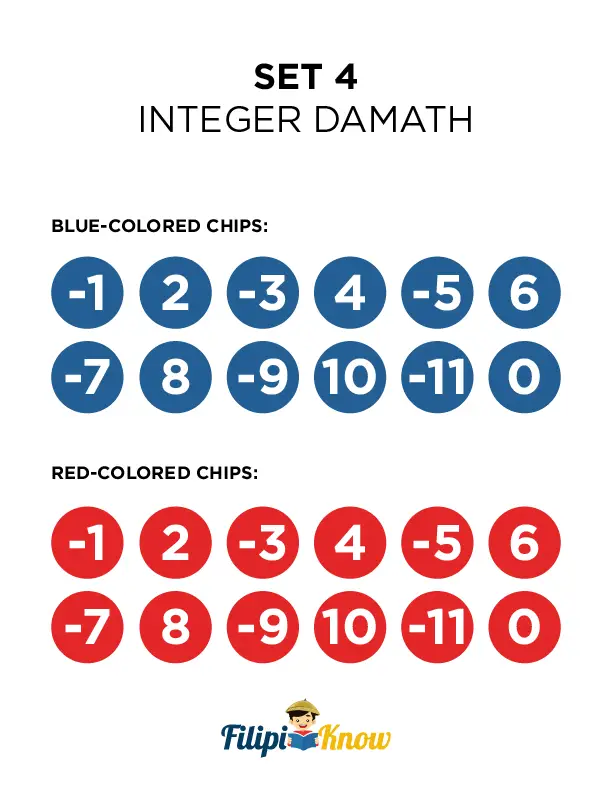
Download the Integer Damath chips in printable PDF format
e. Rational Damath
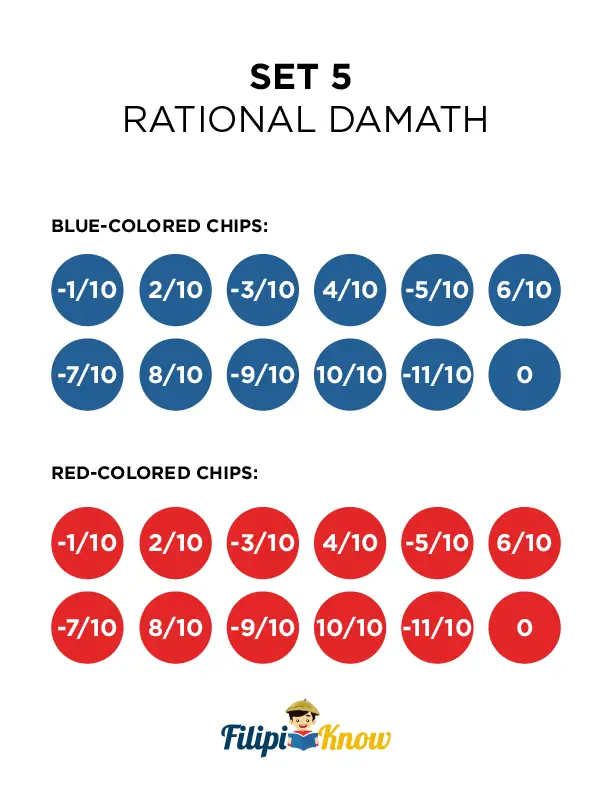
Download the Rational Damath chips in printable PDF format
If you want to create a Damath board and chips and learn how to play the game, continue reading the article below.
What Is Damath?
Damath is a two-player board game used to teach basic mathematical operations to students. “Damath” comes from the words “dama” (which is the Filipino version of the board game checkers) and “mathematics.”
Aside from enhancing students’ mathematical aptitude, Damath also develops their critical thinking skills and sportsmanship.
To play Damath, you need 24 chips with numbers or mathematical expressions (e.g., fractions, radicals, polynomials, etc.) written on them. You will place these chips on the Damath board comprising 64 black and white squares. Each white square has its corresponding mathematical operation.
To win the game, one must get the highest score by capturing his/her opponent’s chips.
A Brief History of Damath
Damath is the brainchild of Jesus L. Huenda1, a teacher from Sorsogon looking for a fresh way to improve his pupils’ arithmetic skills2. Tired of the traditional teaching methods, he came up with an exciting way to teach math: using a board game.
The popularity of Damath extended beyond the Philippines. In 2011, the game reached the United States as Reynaldo Duran3 introduced the game at a Regional Conference and Exposition of the National Council of Teachers of Mathematics (NCTM) in Albuquerque in New Mexico4.
Variations of Damath
There are different ways to play Damath, but its main rules and guidelines remain the same. They only differ in the numbers written on the chips.
Here are some variations of Damath:
- Counting Damath – the chips are numbered from 1 to 12
- Whole Damath – the chips are numbered from 0 to 11
- Fraction Damath – the chips are numbered from 1/10 to 12/10
- Integer Damath – the chips are numbered with positive even integers and negative odd integers (i.e., 0, -1, 2, -3, …, -11)
- Rational Damath – the chips are numbered the same way as in the fraction Damath, but even numerators are positive while odd numerators are negative (i.e., 0, -1/10, 2/10, …, -11/10)
- Radical Damath – the chips are numbered with specific quantities involving square roots
- Polynomial Damath – the chips are numbered with specific algebraic expressions
Materials Needed To Play Damath
1. Damath Board
The Damath board looks like your 8 x 8 checkerboard but has math operations written on its white squares. Shown below is the standard Damath board.

The Damath board also has the numbers 0 to 7 written on its margins. These numbers serve as the indicator for each square on the board. To indicate a square from the Damath board, we read it in a (column, row) manner.
For instance, the marked square in the Damath board below, which is located in column 1 and row 2, is identified as (1, 2).
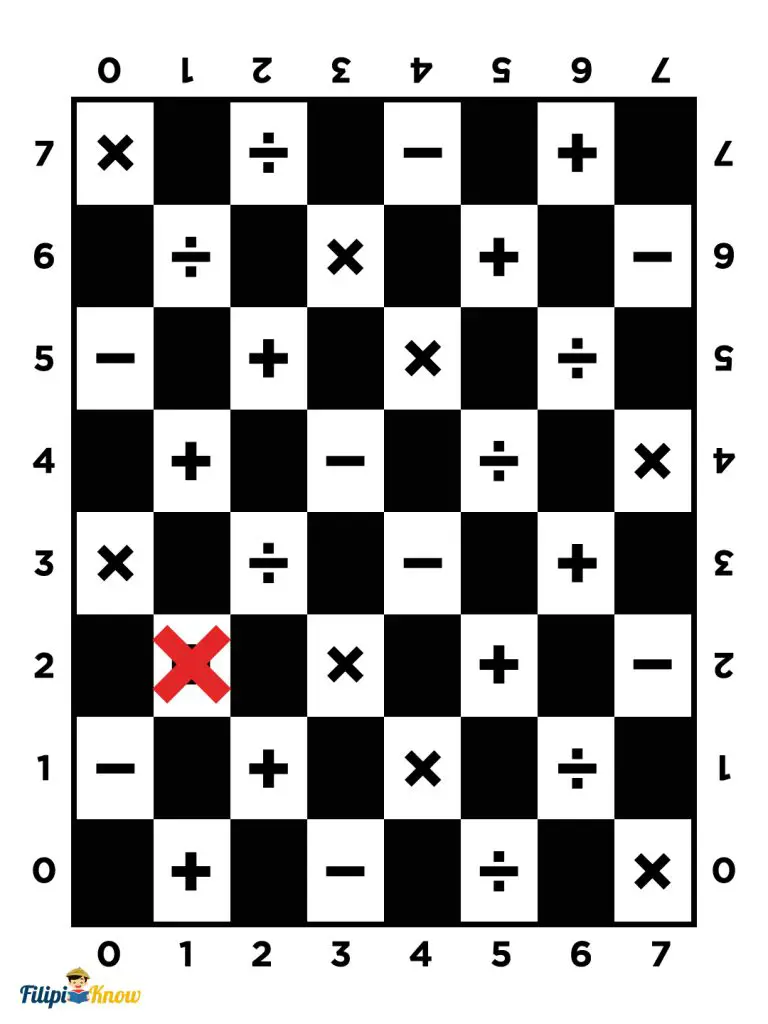
If you want to create a Damath board, follow the steps below:
How To Make a Damath Board
Step 1: Prepare the materials
- ¼ illustration board or 15” x 20” wooden board
- Permanent marker (aka “Pentel Pen)
- Black-ink pen
- Optional: Plastic Cover
Step 2: Using your blank-ink pen, trace a rectangular frame at least 1 inch away from the edge of the cardboard. Make sure that your cardboard is in portrait orientation.
Step 3: Create 64 squares inside the frame using horizontal and vertical lines. Each square must be 1.5 inches wide and 2 inches long.
Step 4: Write the numbers 0 – 7 on the board’s borders. For the vertical (left and right) edges, 0 must be at the bottom, while seven is at the top. For the horizontal edges (top and bottom), 0 must be on the left, while seven is on the right. Please refer to the illustration below.
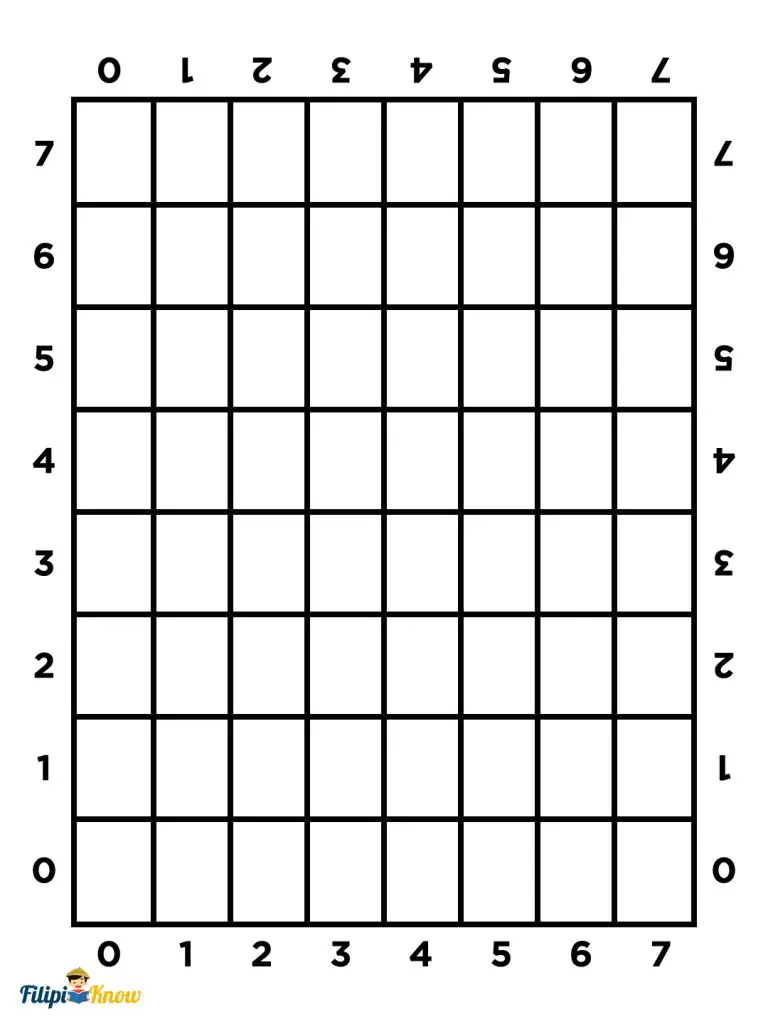
Step 5: Using a permanent marker, shade the square at 0 vertical and 0 horizontal borders. Afterward, alternately shade the squares. The final result must look like the image below.

Step 6: Write the mathematical operations in the white squares. The standard placement of the operations is indicated in the image below.
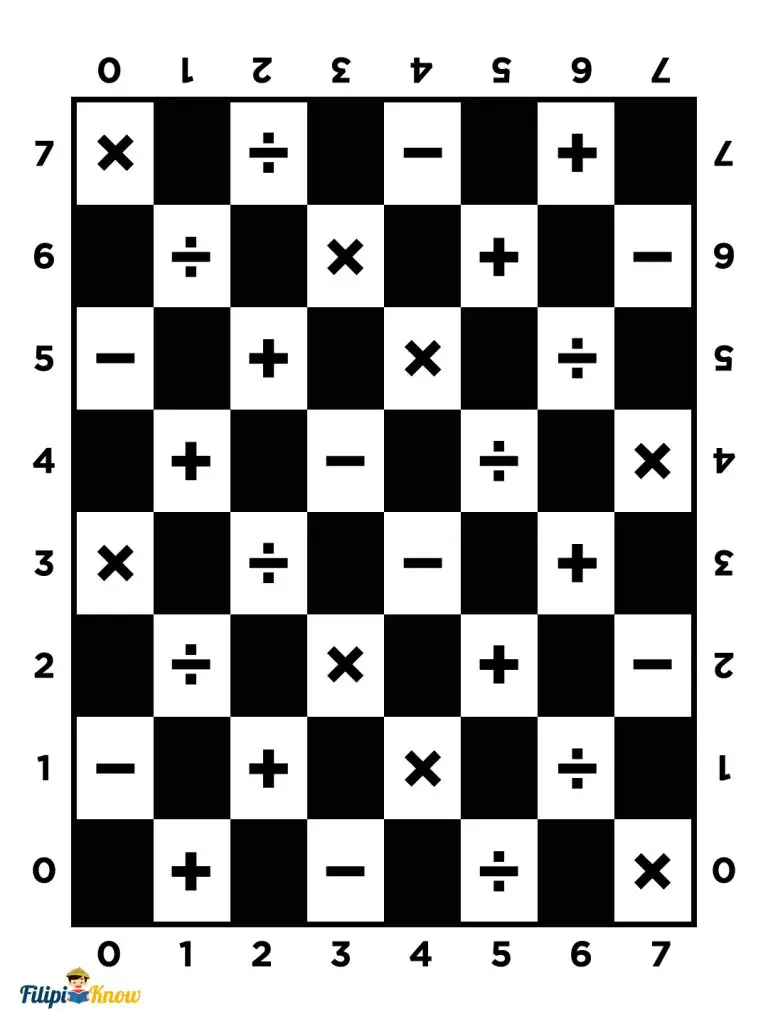
Step 7: To ensure the neatness of the Damath board, you may cover it with a plastic cover.
2. Damath Chips
The chips used in Damath look similar to the ones used in checkers. However, Damath chips have numbers or mathematical expressions written on them.
To make the Damath chips, follow the steps below:
How To Make the Damath Chips
Step 1: Prepare the following materials
- Illustration board
- Permanent marker
- Poster paint (Alternative: glue and colored papers)
- Scissors
Step 2: Cut two strips (measuring two inches wide) from the illustration board. It is advised to make the length of each strip equal to the size of the board.

Step 3: Sketch 12 circles on each strip of the illustration board. Each circle must be 1 inch in diameter. Since you made two strips in Step 2, the total number of circles you’ll sketch must be 24. These circles will be your Damath chips.
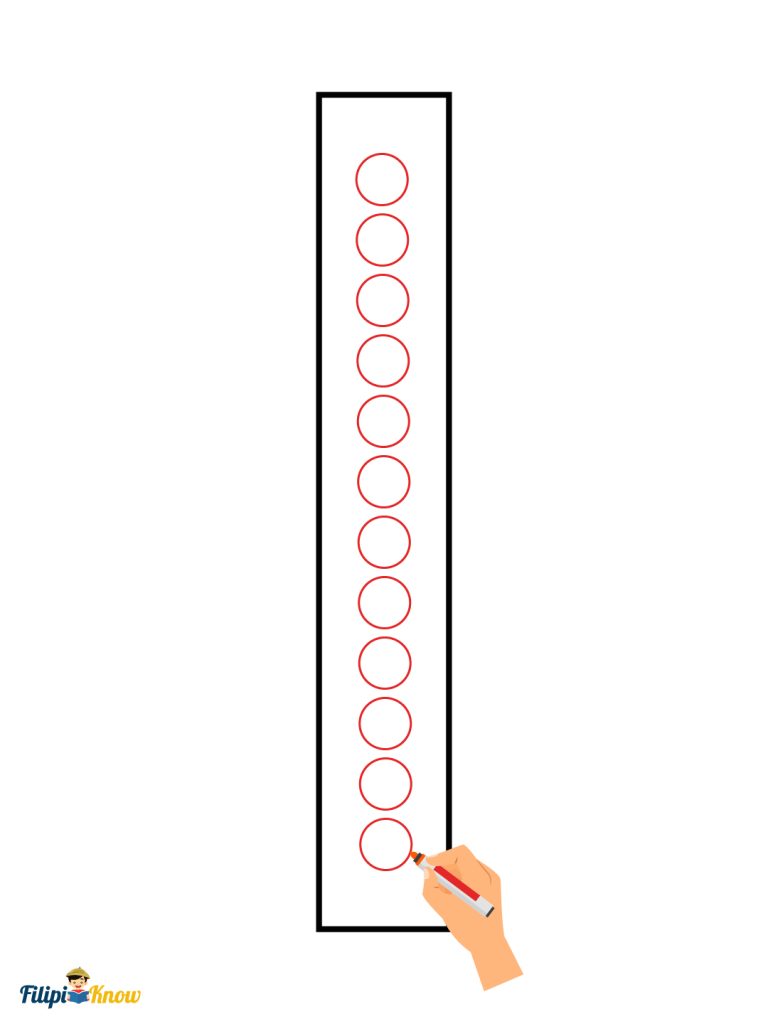
Step 4: Cut the sketched circles from the illustration board.
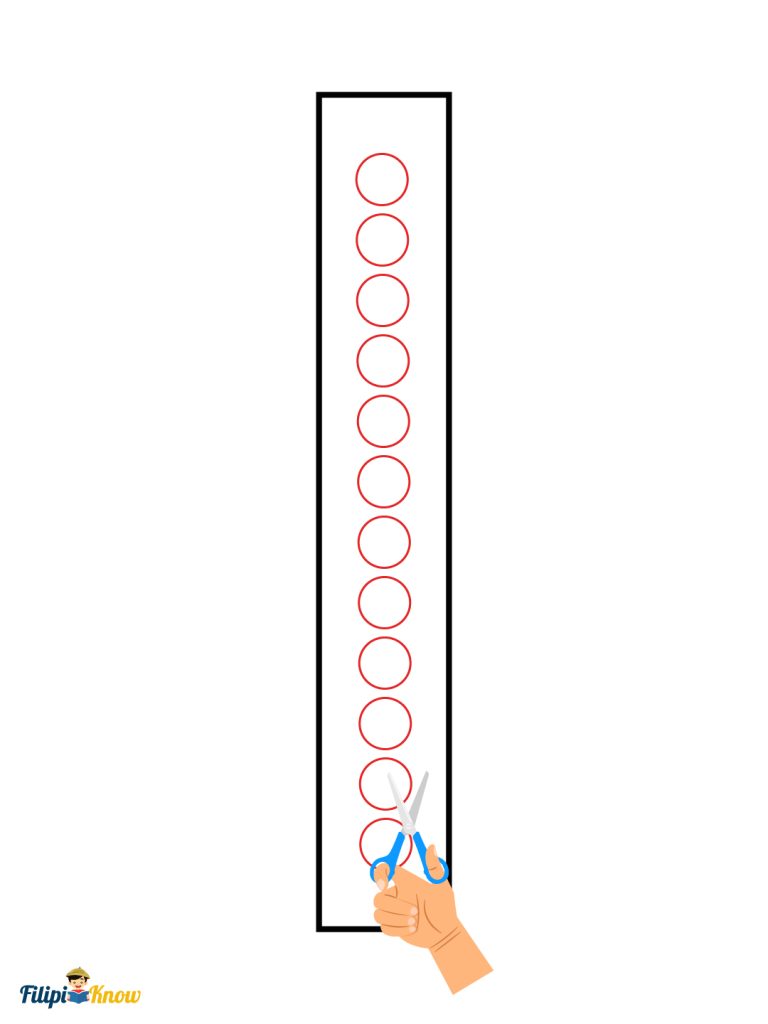
Step 5: Use poster paint to color the chips. Use two different colors for chips. For example, you may use blue for the first set of 12 chips and red for the second set of 12 chips. Wait for the poster paint to dry before proceeding to the next step.
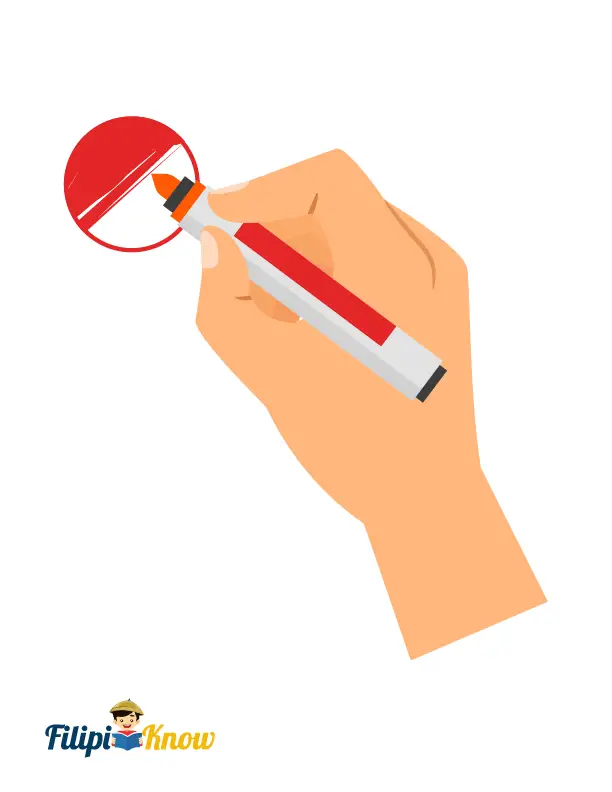
Alternative: If you don’t have poster paint, you may cover the chips with colored paper instead. To do this, sketch 12 circles from one colored paper and another 12 circles from a different colored paper. The circles must have the same diameter as the chips. Afterward, cut the sketch and paste it on the chips using glue.
Step 6: Write the numbers on the chips. The numbers you will indicate in the chips depend on the variation of Damath you want to play. Please refer to the section “Variations of Damath” for more information.
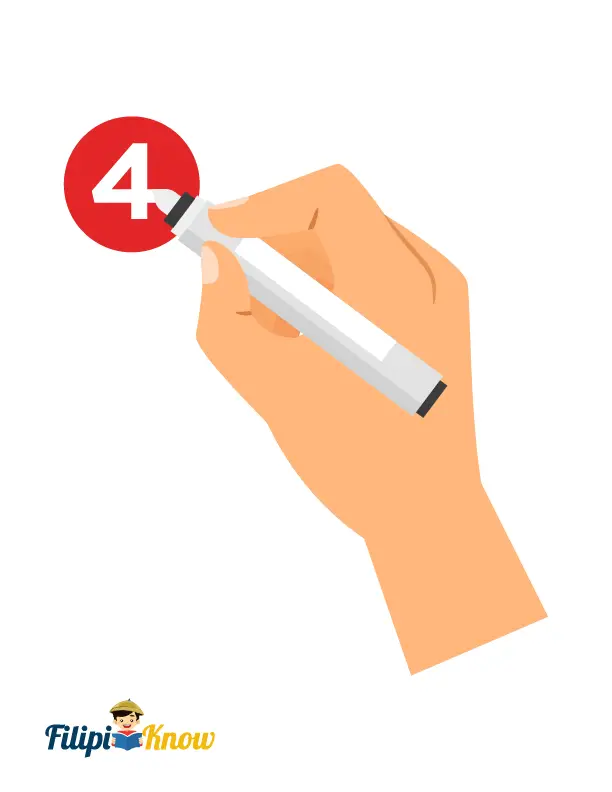
3. One-Peso Coin
You will toss this to identify which player will move first.
4. Timer
You can use your mobile phone’s stopwatch as your game’s timer.
5. Damath Scoresheet
Damath competitions use standard score sheets to record and tally the players’ scores. Shown below is an example of a Damath Scoresheet.
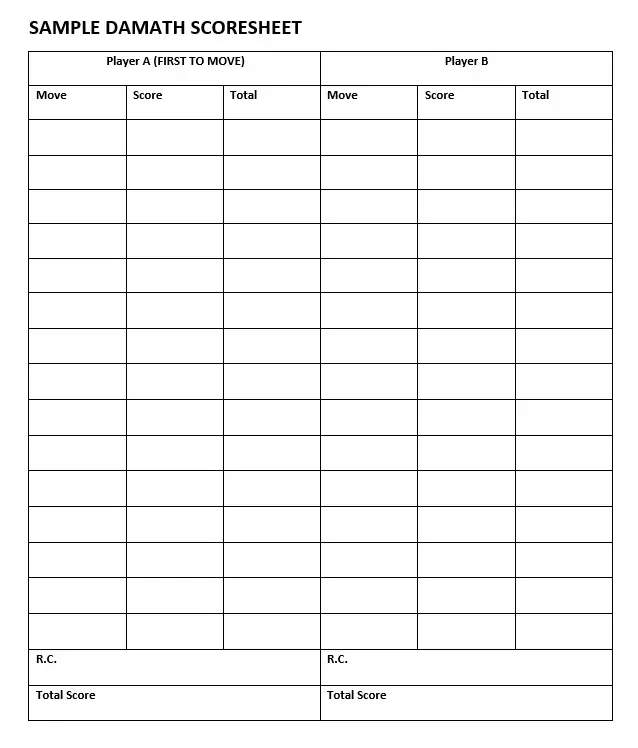
How To Play Damath (Damath Rules and Mechanics)
1. Starting the Game
- Position the chips in the Damath board.
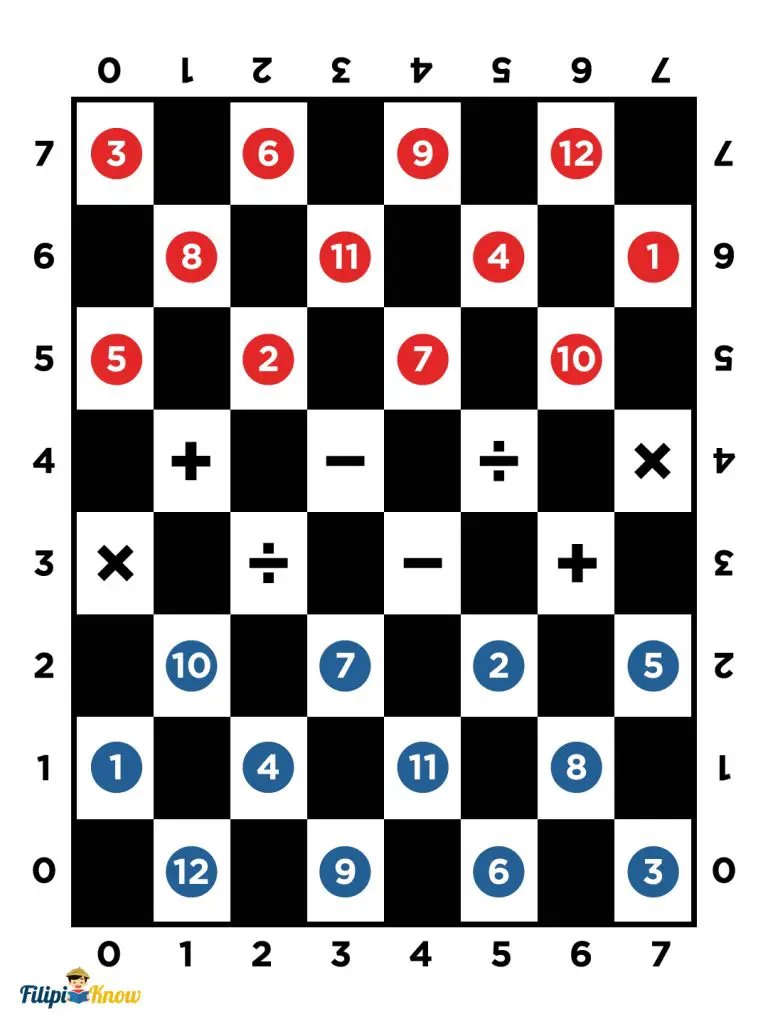
- Toss a coin to identify which player will move first.
2. Moving the Chips
Players can only slide their chips into an empty white square adjacent to it. Backward slides are not allowed unless the player captures an opponent’s chip. For instance, blue chip #10 in the image below is allowed only to move in the white squares indicated by the arrows.
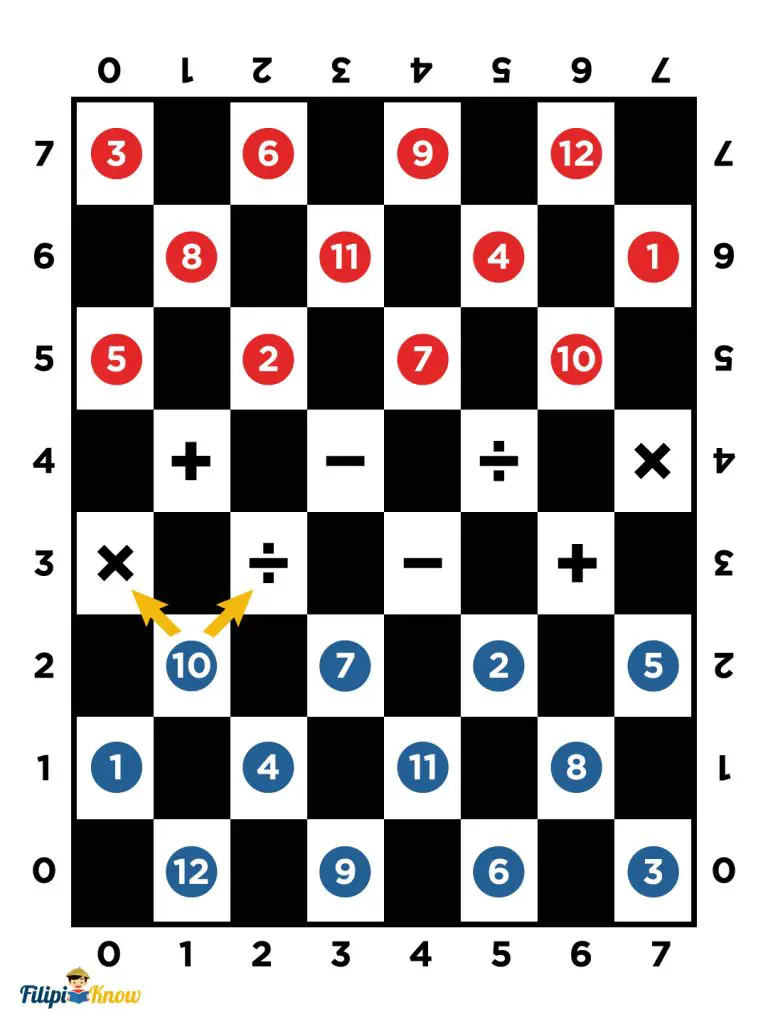
- Players take turns in moving a chip. Passing a turn is not allowed.
- “Touch move” applies to this game. Once a player touches a chip during his/her turn, he/she is now required to move it.
- Players have 60 seconds each turn to move a chip.
3. Capturing an Opponent’s Chip and Scoring
- To capture an opponent’s chip, the taker chip must “jump” over its opponent’s chip diagonally and land on the empty white square adjacent to the opponent’s chip. A chip can be captured by “jumping” diagonally forward or backward.
- Denying a capture is not allowed.
- Once a taker chip captures its opponent’s chip, the taker obtains a score. The score is calculated using the mathematical operation indicated in the white square where the taker chip lands. The indicated operation will be used to the designated numbers in the taker and captured chips.
4. Earning the “Dama” Chip
- The dama chip is an “upgraded” chip that gives players an advantage by moving through multiple squares.
- Once a player’s chip reaches the following squares of its opponent: (1, 0), (3, 0), (5, 0), (7, 0), that chip becomes a “dama” chip. Meanwhile, if one of the opponent’s chips reaches any of the following squares: (0, 7), (2, 7) (4, 7), (6, 7), then the opponent’s chip becomes a “dama” chip.
- A dama chip can be moved by sliding diagonally forward or backward. It can be moved in any empty square, provided there’s no chip blocking its way.
- Like an ordinary chip, the dama chip captures an opponent’s chip by jumping over it diagonally. The mathematical operation indicated in the white square where it lands must be used to the designated numbers of the dama chip and the captured chip to calculate the score. However, the sum, difference, product, or quotient made by the dama chip must be doubled.
- The score obtained is also doubled if an ordinary chip captures a dama chip or when a dama chip captures another dama chip.
5. Concluding the Game
- The game ends after 20 minutes, or if one player cannot move any of his/her chips because it is “trapped.”
- The scores garnered by each player by capturing their opponent’s chips are added together to obtain the final score. The numbers indicated in the remaining chips on the board are also added to the final score. Note that the corresponding additional score is doubled for the remaining dama chips.
- The player that garnered the highest final score wins the game.
Tips and Warnings
- Always aim to capture high-numbered chips for addition and multiplication. If you have to “sacrifice” or lose a chip, minimize your opponent’s score by forcing him/her to land in a subtraction or division square.
- Be careful in recording your scores in the Damath scoresheet. Game facilitators might penalize you for incorrect entries.
Frequently Asked Questions
1. Are Dama and Damath the same?
Dama and Damath are different board games.
Dama is a variant of the board game “checkers,” where players capture their opponent’s piece by jumping/leaping. The winner of this game is the one who first captures all of his/her opponents’ chips.
On the other hand, Damath involves mathematical calculations for every capture. Your goal is to wipe out your opponents’ chips and choose your captures wisely to maximize your score.
2. Are there Damath games available online?
There are a couple of online Damath games you can try to improve your strategy. Examples are the following:
References
- DepEd promotes ‘Damath’. (2010). Retrieved 2 August 2022, from https://www.philstar.com/headlines/2010/02/20/550971/deped-promotes-damath
- Erasmus+ Project. (2015). Math-GAMES Compendium [Ebook] (1st ed., pp. 22-26). Retrieved from https://ec.europa.eu/programmes/erasmus-plus/project-result-content/9fa79d5d-ecee-4b1b-a154-9647e7097dc9/Math-GAMES%20IO1%20EN.pdf
- Let’s Play Damath!. (2011). Retrieved 2 August 2022, from https://nctm.confex.com/nctm/2011NM/webprogram/Session4964.html
- Houghton Mifflin Harcourt Publishing Company. (2011). NCTM 2011 Regional Conference and Exposition [Ebook] (pp. 1-80). United States of America. Retrieved from https://www.nctm.org/uploadedFiles/Conferences_and_Professional_Development/Regional_Conferences_and_Expositions/2011%20Albuquerque%20Program%20Book.pdf
Written by Jewel Kyle Fabula
Jewel Kyle Fabula
Jewel Kyle Fabula graduated Cum Laude with a degree of Bachelor of Science in Economics from the University of the Philippines Diliman. He is also a nominee for the 2023 Gerardo Sicat Award for Best Undergraduate Thesis in Economics. He is currently a freelance content writer with writing experience related to technology, artificial intelligence, ergonomic products, and education. Kyle loves cats, mathematics, playing video games, and listening to music.
Copyright Notice
All materials contained on this site are protected by the Republic of the Philippines copyright law and may not be reproduced, distributed, transmitted, displayed, published, or broadcast without the prior written permission of filipiknow.net or in the case of third party materials, the owner of that content. You may not alter or remove any trademark, copyright, or other notice from copies of the content. Be warned that we have already reported and helped terminate several websites and YouTube channels for blatantly stealing our content. If you wish to use filipiknow.net content for commercial purposes, such as for content syndication, etc., please contact us at legal(at)filipiknow(dot)net